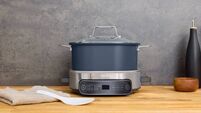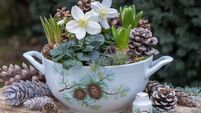Vintage view: Looking after the family silver (and copper, and brass...)

IT’S haunting to see some people cheerfully dredge their metal pieces from a torn shopping bag on the BBC’s Antiques Roadshow. As the object ignites into view, how often the light gutters in the eyes of the expert, followed by the mournful, falling intonation ‘oh — I see, you’ve polished it’.
The specialist seems almost indifferent to picking the thing up after this polite bit of covert scolding, and prods it around the velvet-topped table before giving the bad news. Value has been diminished with too much love and hefty applications of Brasso.
There’s a difference between cleaning and determined polishing, and often a light clean is all that’s needed to preserve vintage metals in top condition. Long-term cleaners for a range of metals leave a protective coating, cutting back on the need for all that lethal elbow grease.
Starting with silver, it might be a metal (sterling is technically an alloy as it has 7.5% copper included) but keep in mind how soft it is. The finer the silver the more vulnerable it is to dents, scratches and surface erosion during well meant attempts to sparkle it up. Clean silver on a padded surface to ensure you don’t drive the piece down too hard, bending fragile spouts or handles. If you have used your silver or silver plate for the table at New Year, it may be carrying traces of salt or other foodstuffs that can eat away at the piece leaving discreet damage or a green stain.
An occasional wash in mild soapy water (avoid immersing the piece completely as small voids can sop up water) and a polish off with a clean, butter-soft old tea-towel, is often all table silver needs. Rinse off all polish from cutlery. I’ve had a wincing mouthful of ammonia and gazpacho from a Georgian fork.
If you have salts, take any glass liner out — empty, wash, dry and return, ensuring no grains are caught between the glass and the body of the salt. Find the most yielding toothbrush you can (those 0-2 brushes for tiny children are ideal) and prod around crevices and fine detail.
For troublesome tarnish, there are dedicated foams, creams and cloths impregnated with cleaner to gently lift the oxidation, leaving a lasting protective coating. Sheffield and electro-plate can thin out if attacked roughly with heavy hands and products not intended for silver. Go very easy on any engraved detail, inscriptions, hallmarks, filigree or intentional texture on silver, as it will simply rub out over time if over-cleaned.
For supreme protection, handle your silver in soft cotton gloves, keeping it free of the lipids, oils and acids on your fingertips that over time can pit the surface. Gold in its purest form, 24ct, is the only metal known not to corrode, but many metals can be dull with oxidation without being in danger.
Any powdering on the surface of metal, generally spells more serious problems and these should be taken to a specialist only. Be wary of spraying any antique metal with general furniture cleaner as it can hang around as toxic, moist droplets on the surface. Metals are best stored in non-acidic materials, and keep them clear of leather which can start up a staining chemical reaction. Pewter can be maintained with just a wipe over. For really dirty pieces, soak a cloth in boiled linseed oil and talcum powder and apply gently. Wipe the mixture off with methylated spirits before giving it a soapy wash, rinse and gentle dry.
Copper and brass, if not already coated in a modern electrophoretic lacquer, are reasonably tough and can be cleaned of heavy tarnishing with a dedicated commercial product. However, less is more. Back off and leave them that bit duller if the piece is of any real value. A whip over with a long-term silver polishing cloth is suited to copper and brass too, leaving an atmospheric barrier that will cut down on further tarnish. Even home-made pastes (lemon juice/baking powder is a favourite) are not 100% safe and can drip onto adjoining wood surfaces as you struggle to clear up the blasted cleaner. Never, ever, no matter how teasing the inducement, polish up old patinated bronze. A loving caress with a non-abrasive lint-free cloth will lift dust and ingrained dirt. That green, grey grubby surface is part of the pieces’ character, and once off, there is no way of returning the gentle oxidation of ages.












